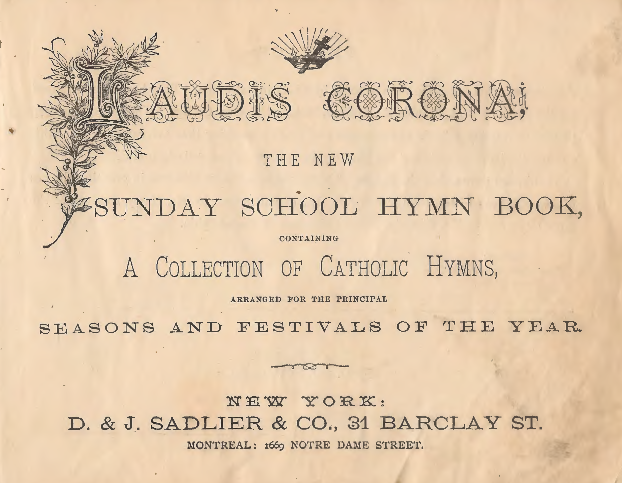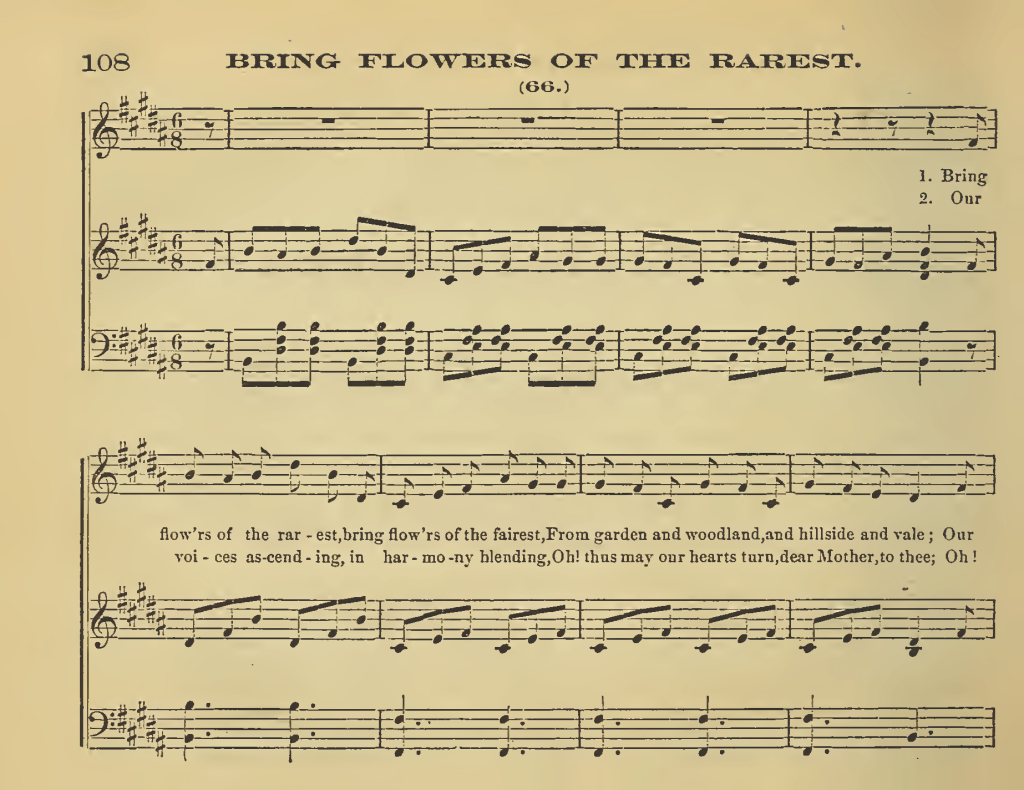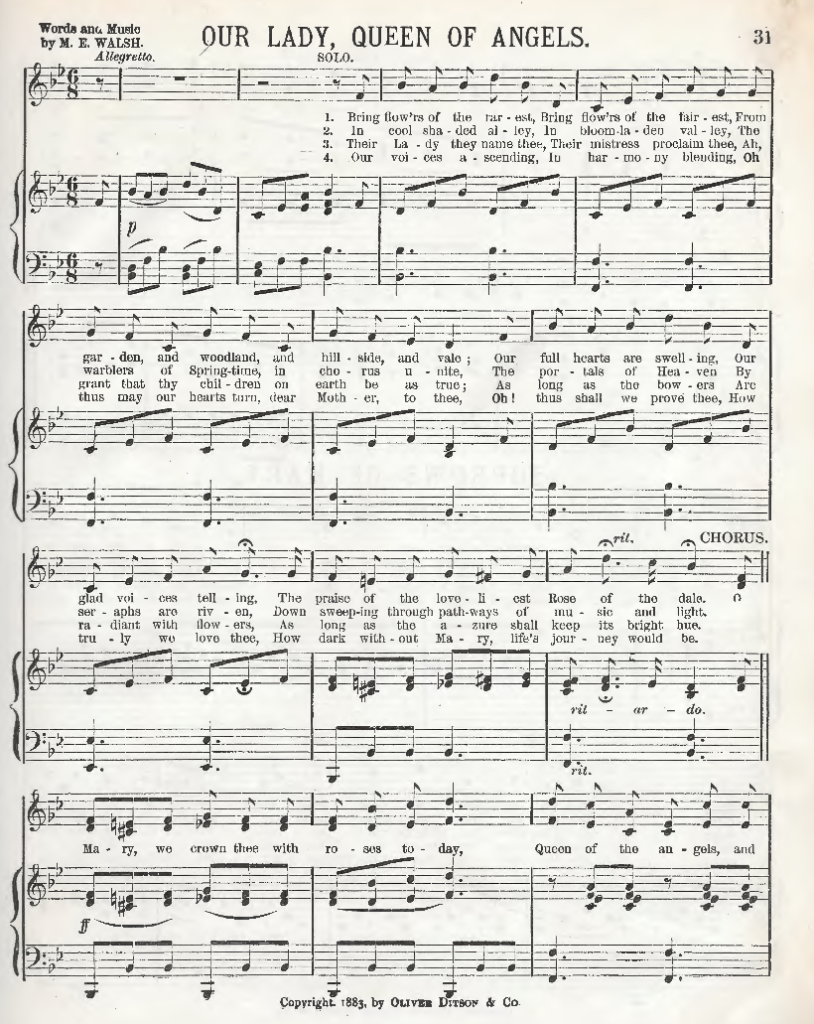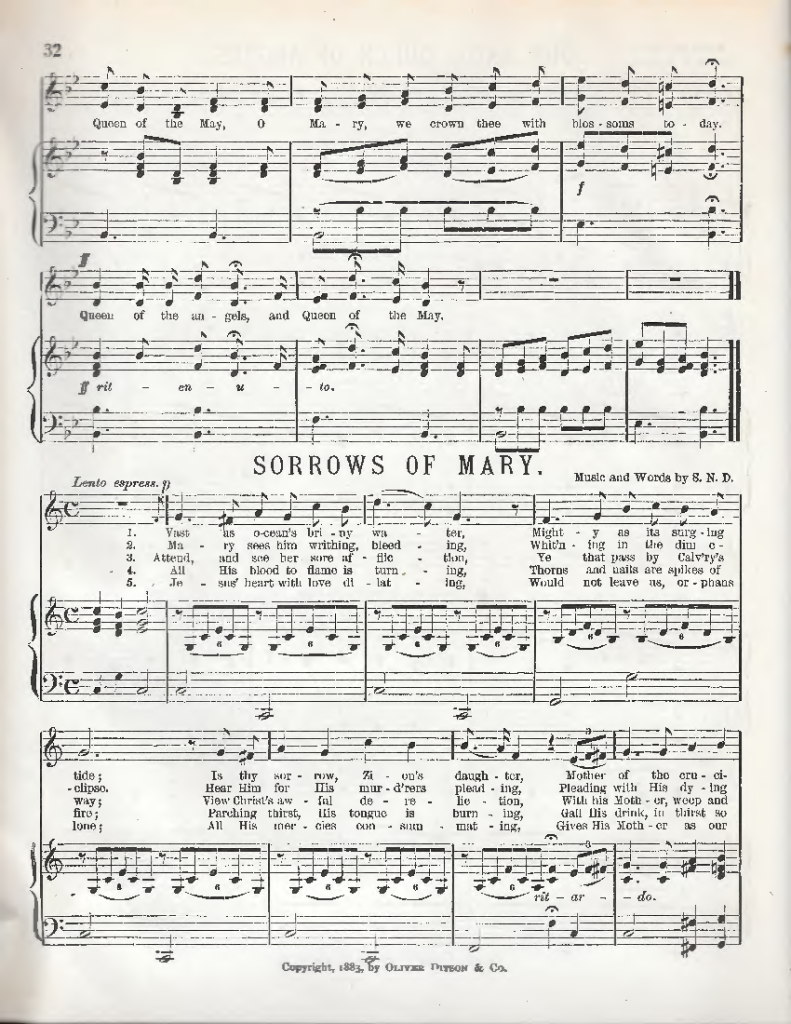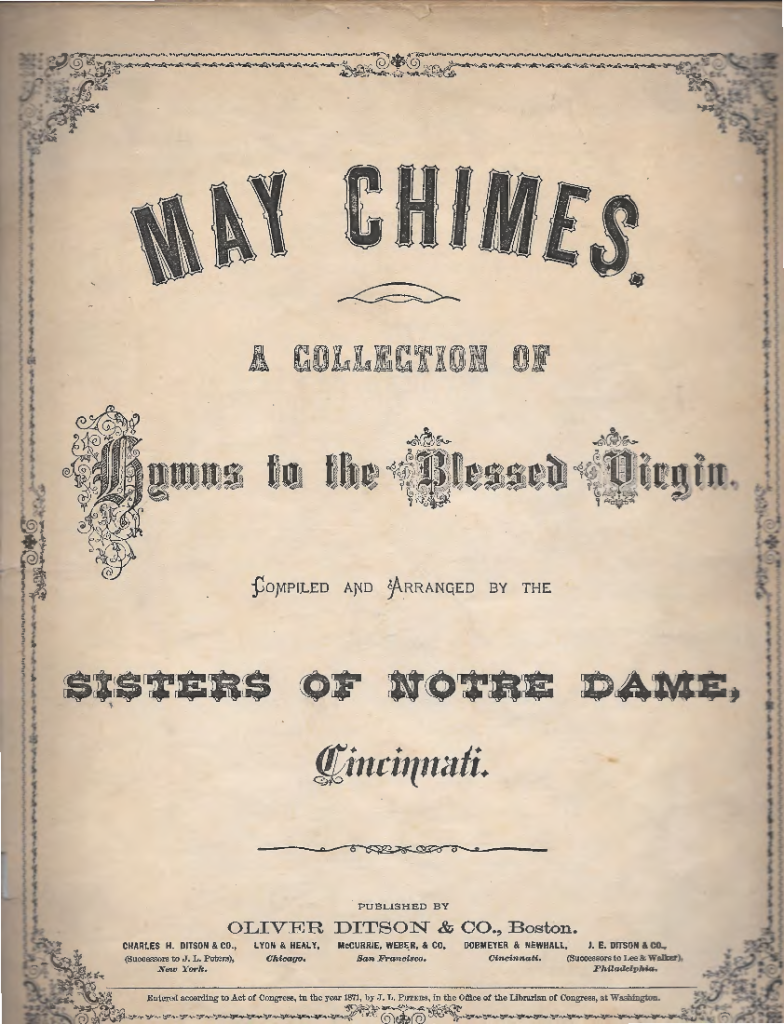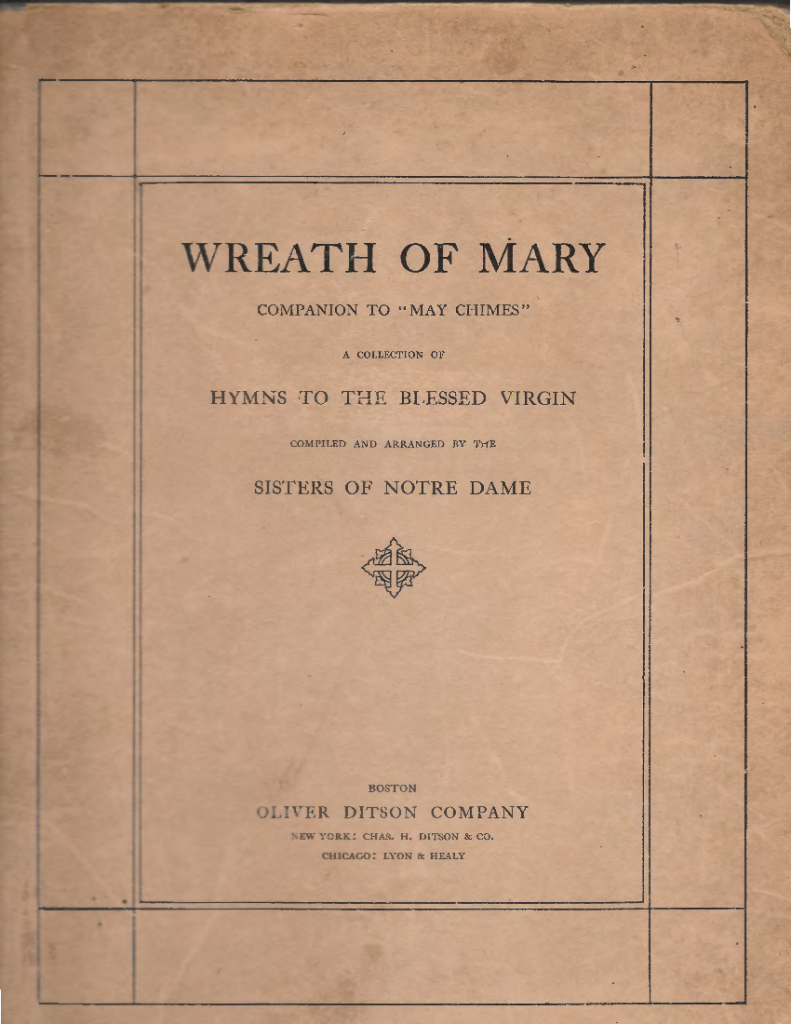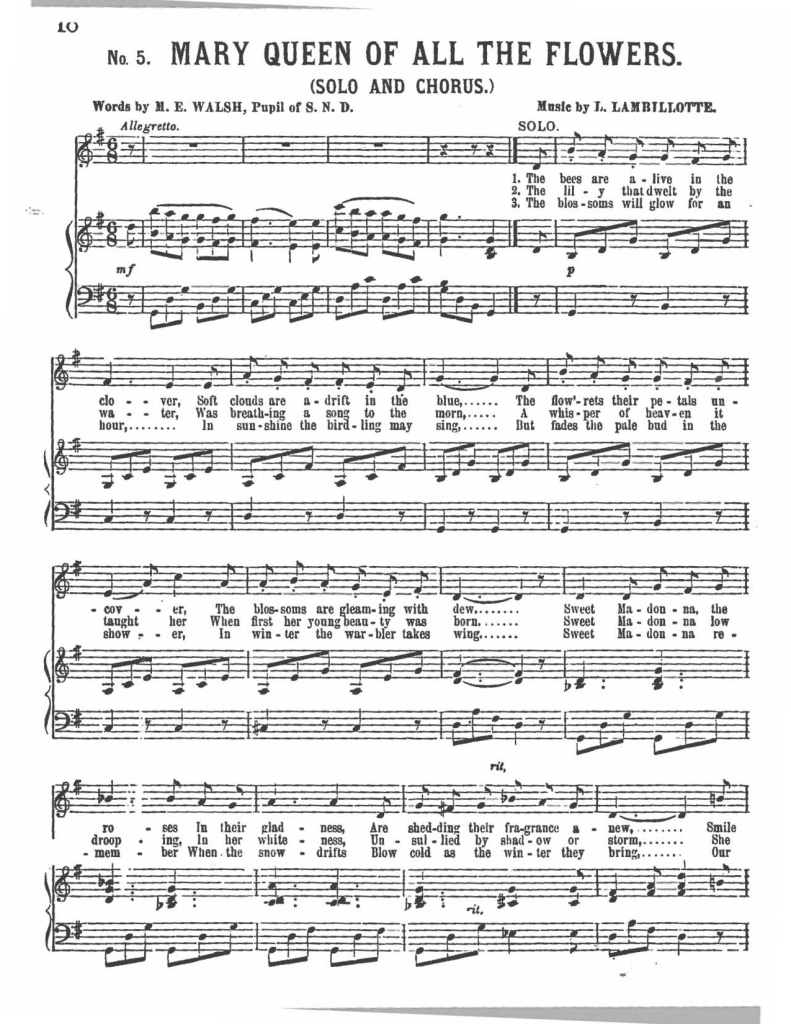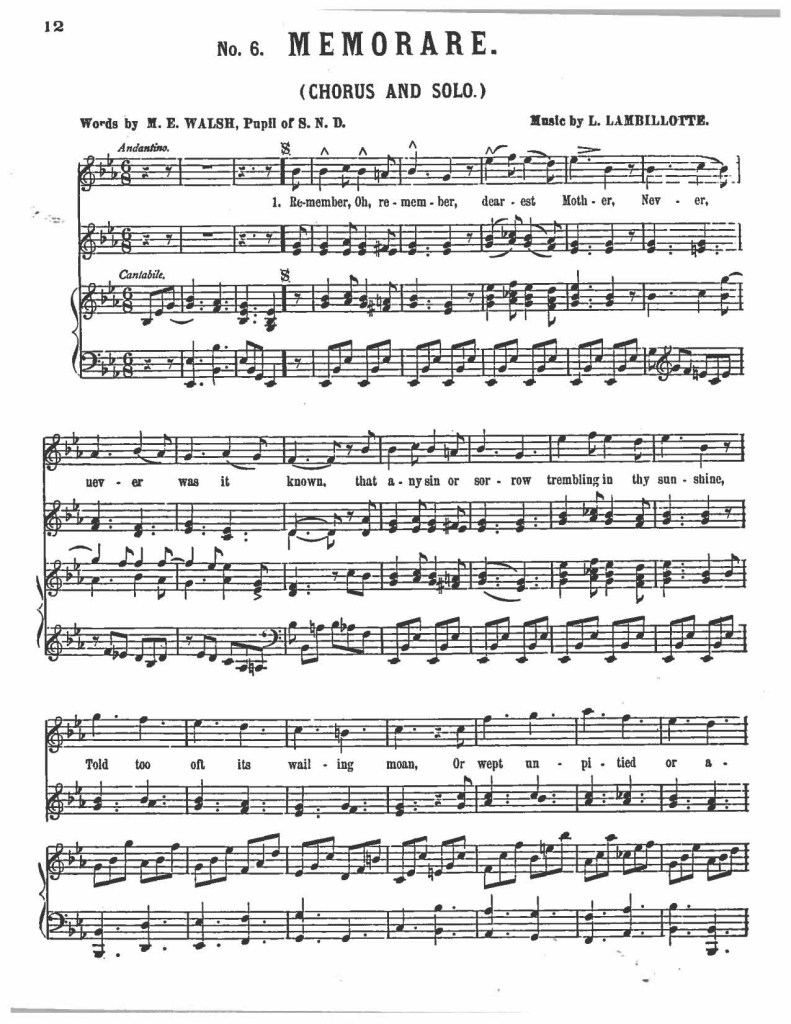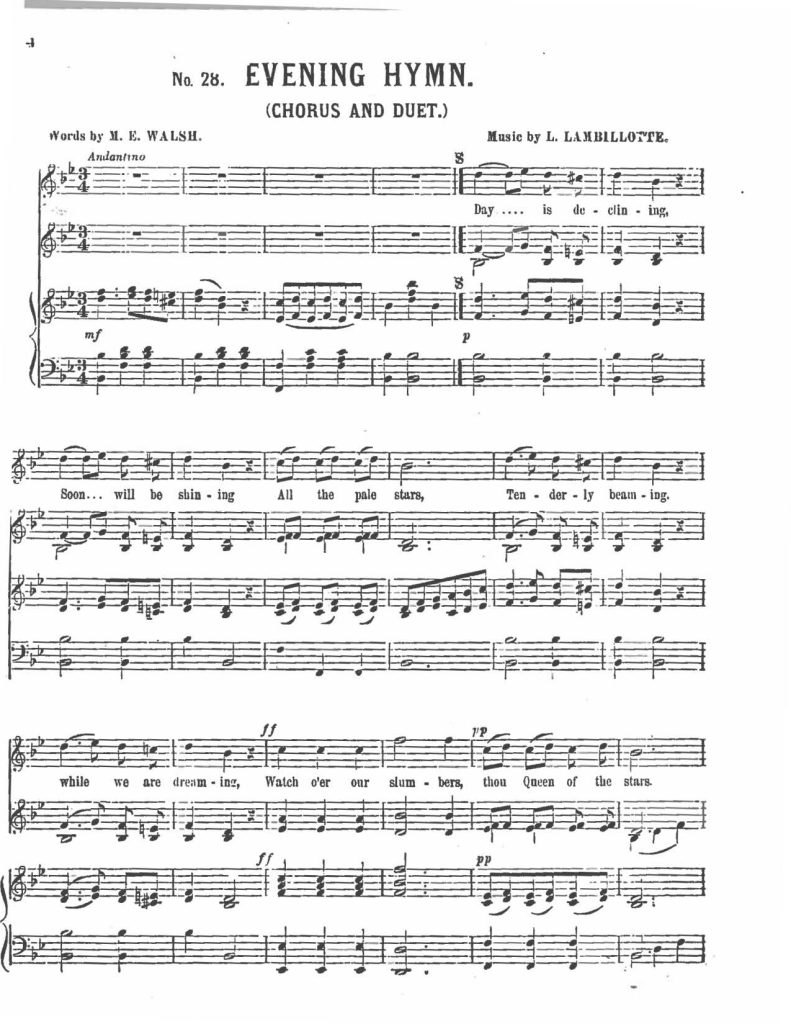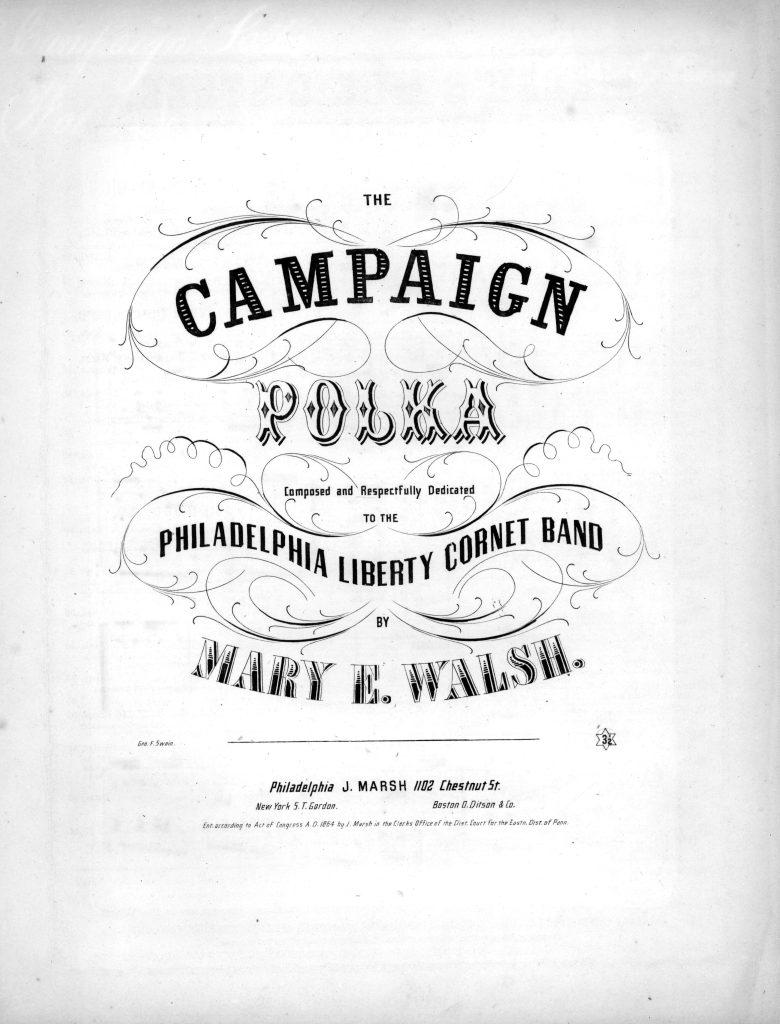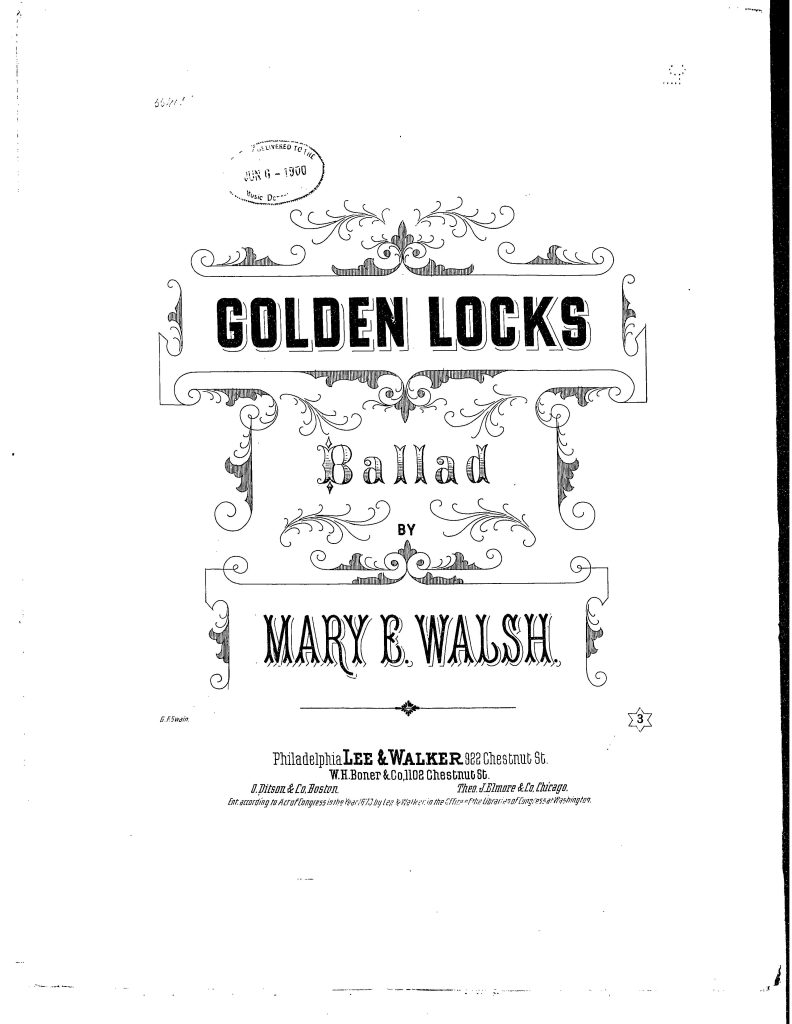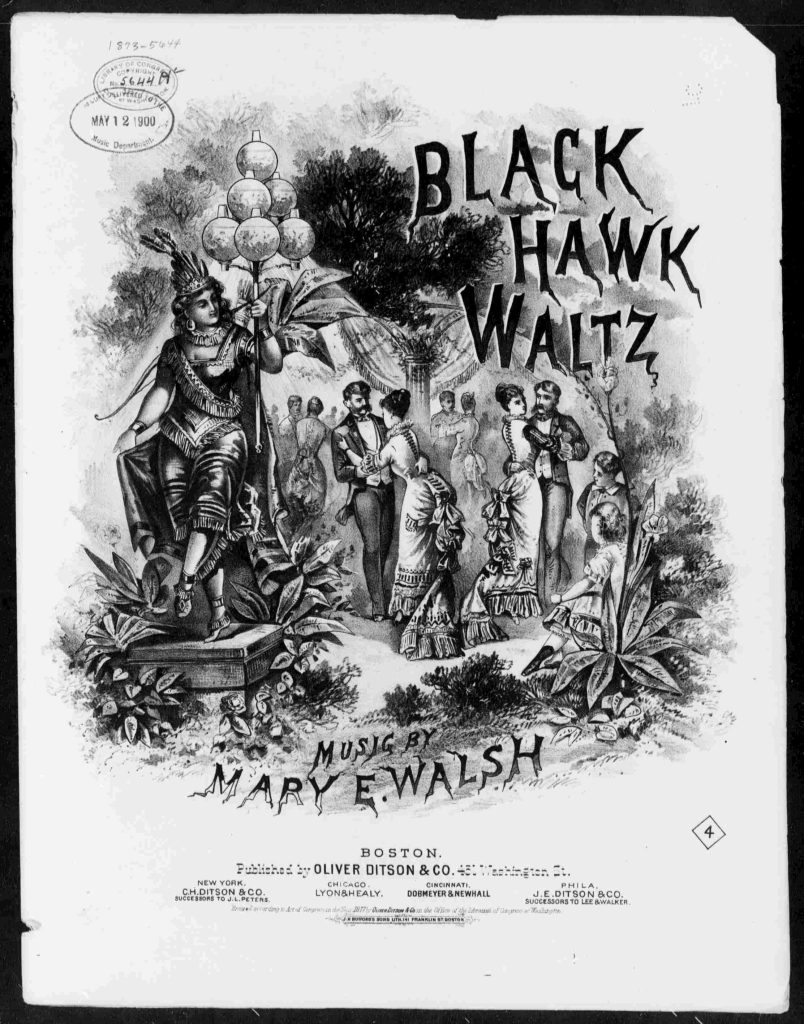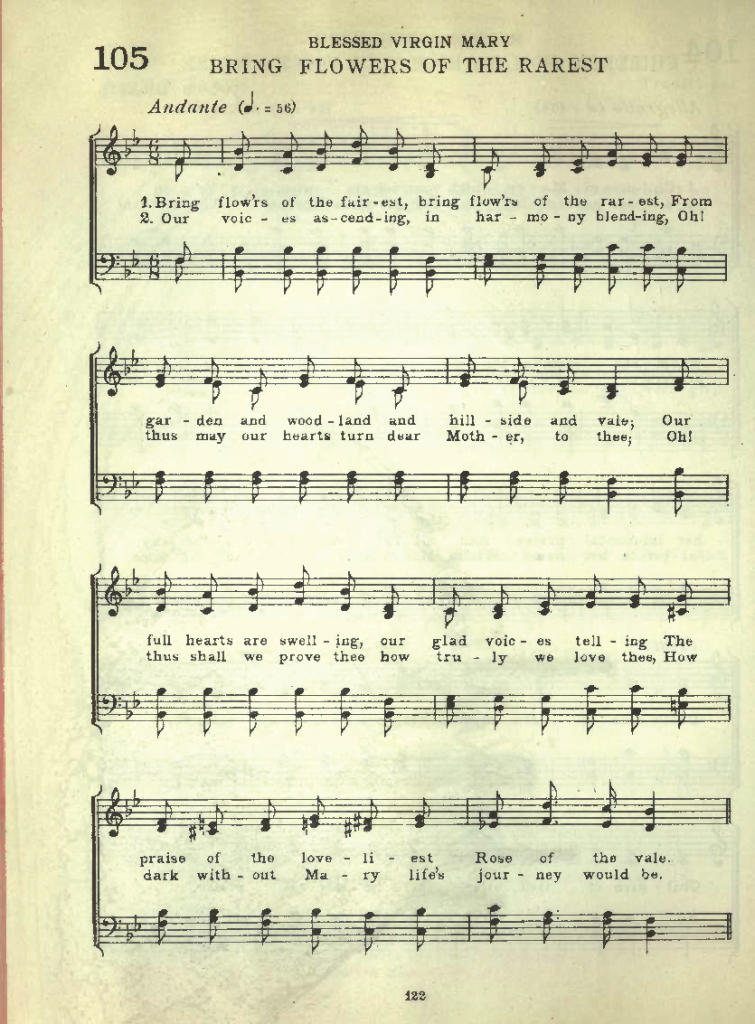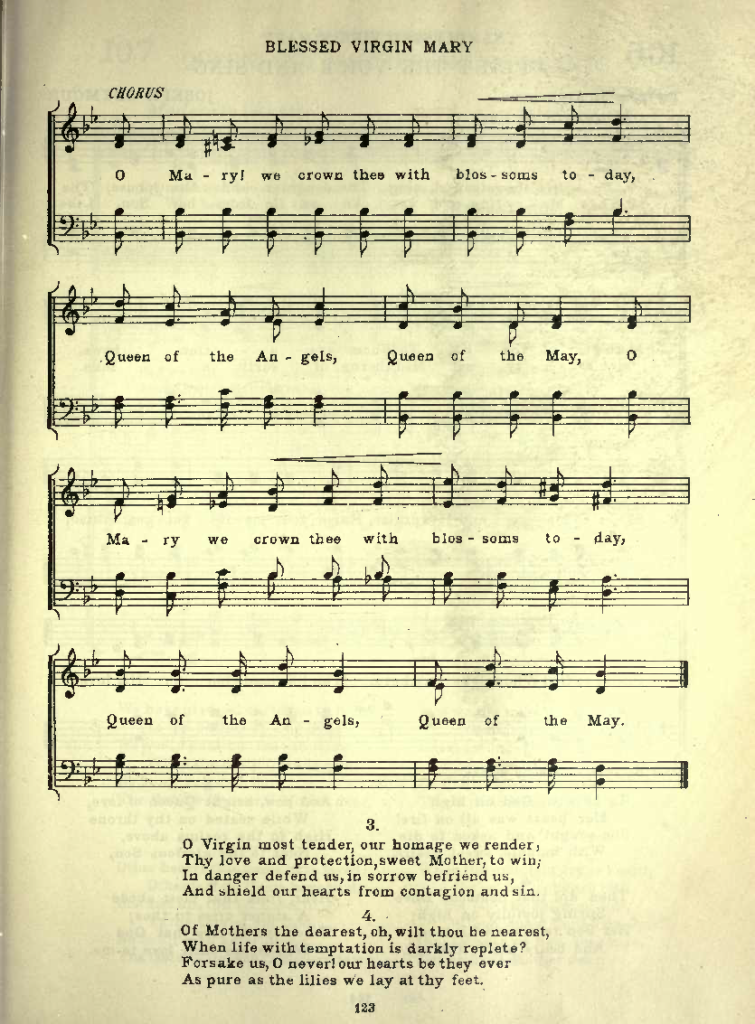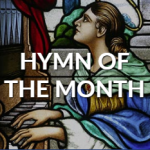This hymn, sometimes referred to as the Crowning Hymn because of its chorus, O Mary, We Crown Thee with Blossoms Today, is the most widely used and well-loved of all Marian hymns for May Crowning. Even though other crowning hymns were composed, this hymn was never superseded. The earliest appearance of the hymn is found in the LAUDIS CORONA, 1880 hymnal with no attribution given to the author or composer. In the Preface of this hymnal the publishers give thanks to the Sisters of Notre Dame for their kindness in granting permission to use selections from their hymnal MAY CHIMES, 1871.
A few years later the hymn was published in the WREATH OF MARY, 1883 and captioned Our Lady, Queen of Angels with attribution for the words and music by Mary E. Walsh. This hymnal was compiled and arranged by the Sisters of Notre Dame de Namur of Cincinnati, Ohio.
The Sisters of Notre Dame de Namur came from Belgium and arrived in Cincinnati, Ohio in 1840. They began teaching in the Philadelphia area in 1856. The Sisters of Notre Dame de Namur of Cincinnati, Ohio compiled the WREATH OF MARY and MAY CHIMES hymnals. The hymnals consist mainly of Marian hymns written and composed by the Sisters and their students. The hymnals were published by the Oliver Ditson, Co., Boston. The Oliver Ditson Company was one of the major publishing houses of the late 19th century with offices in New York, Chicago, San Francisco, Cincinnati, and Philadelphia.
Mary E. Walsh wrote three other hymns including Mary Queen of All the Flowers, the Memorare, and Evening Hymn. These appeared in the hymnal MAY CHIMES.
Bring Flowers of the Rarest appeared in other Catholic hymnals including the CONVENT HYMNS AND MUSIC, 1891 (London); the SUNDAY SCHOOL HYMN BOOK, 1887, 1907, and 1935 editions; the HOLY FAMILY HYMN BOOK, 1904; ST. BASIL’S HYMNAL, 1888 thru 1953; the NOTRE DAME HYMN TUNE BOOK, 1905 (London); The STANDARD CATHOLIC HYMNAL, 1921; ST. JOSEPH’S HYMNAL, 1930; HYMNS USED BY THE PUPILS OF THE SISTERS OF NOTRE DAME, 1921 and 1948 editions; the ALVERNO HYMNAL PART 3, 1953: and THE CATHOLIC CHAPEL HYMNAL, 1944, 1949, 1958 and 1968 editions.
Two other melodies were composed for this hymn. The first is by Peter Piel (1835-1904) a well-known German composer with over forty mass settings and other compositions for music in the church. Then the hymn was set to a melody composed by Michael Haydn (1737-1806) an Austrian composer and younger brother of the more celebrated Joseph Haydn. These melodies never attained wide use and were soon forgotten.
The history books are silent when it comes to Mary E. Walsh, not much is known about her. So, I contacted the archivist with the Sisters of Notre Dame de Namur located in Cincinnati, Ohio and the archivist had this to say, I find no Mary Walsh of any kind that entered our community and was born before the song was written. Some of the works of Mary E. Walsh show that she was a pupil of the Sisters of Notre Dame. The archivist could not verify that Mary E. Walsh was a student and indicated, that there are very few surviving student lists, and they do not go back far enough.
Mary E. Walsh’s other contributions are in the secular field, and they include, The Campaign Polka, a musical composition for the Philadelphia Cornet Band published 1864; the Golden Locks Ballad, published in 1873, by Lee & Walker a Philadelphia music company, and the Black Hawk Waltz, published in 1874 by the Oliver Ditson Co., and is based on the story of the famed Chief Black Hawk (1767-1838). The Black Hawk Waltz is still popular today and is used by some music teachers as an important teaching piece.
Reflection
I learned to sing Bring Flowers of the Rarest while singing in St. Mary’s Choir (in Akron, Ohio) and attending the May Crownings where this hymn was lovingly sung by all with vigor and devotion. We used the ST. BASIL’S arrangement at St. Mary’s.
Many of the saints have referred to Mary’s Psalter and the Rosary beads as flowers, particularly roses and even more so as the prayers we offer up. It is not the earthly flowers we bring from our gardens and place on Our Lady’s altar or crown Her with but those flowers/ prayers we bring from our spiritual garden. Some are fair, those we say in haste, and some are the rarest, those we say on the spot or that come devoutly said from our hearts and minds. It is traditional to place on the head of a statue of Mary a wreath of red and white roses symbolic of motherhood and virginity.
To me, one of the most moving phrases is found in the second verse, How dark without Mary life’s journey would be. How dark indeed would the life of the church be without our Blessed Mother and how lost we would be if Christ had not bequeathed His mother to us from the Cross. I believe this to be an allusion to the words our Lord spoke to us, I will not leave you orphaned (John 14:18).
As mentioned above we would sing Bring Flowers of the Rarest at St. Mary’s for our May Crowning which was usually an outdoor parish event that took place on the parish grounds (weather permitting) around 2 o’clock in the afternoon, otherwise the May Crowning was in the church.
The May Crowning program for 1982 consisted of the following Marian hymns: Mary, Dearest Mother; Mother Dear, O Pray for Me; Bring Flowers of the Rarest; O Queen of the Holy Rosary; ‘Tis the Month of Our Mother; Mother Dearest, Mother Fairest, followed by a prayer of consecration to Our Blessed Mother and benediction which included the traditional O Salutaris, Tantum Ergo, the Divine Praises; Holy God We Praise Thy Name and finally Jubilate Deo (Glory to God) composed by Alphonse Weiss and arranged for four voices by James A. Reilly of McLaughlin and Reilly Music Co.
Below are recordings from a cassette tape of the hymns we sang at St. Mary’s May Crowning in 1982. After almost forty years I was surprised that this cassette tape played at all. It’s wonderful to hear my friends who sang in the choir.
A newly commissioned recording of Bring Flowers of the Rarest and other May Crowning hymns sung by the Seraphim Singers at Holy Name Church, Boston can be found on The Devotional Hymns Project website produced by Peter Meggison.
All the hymns presented here are in the public domain. It is my hope that these hymns will once again become a favorite of parish or choir repertoire.

